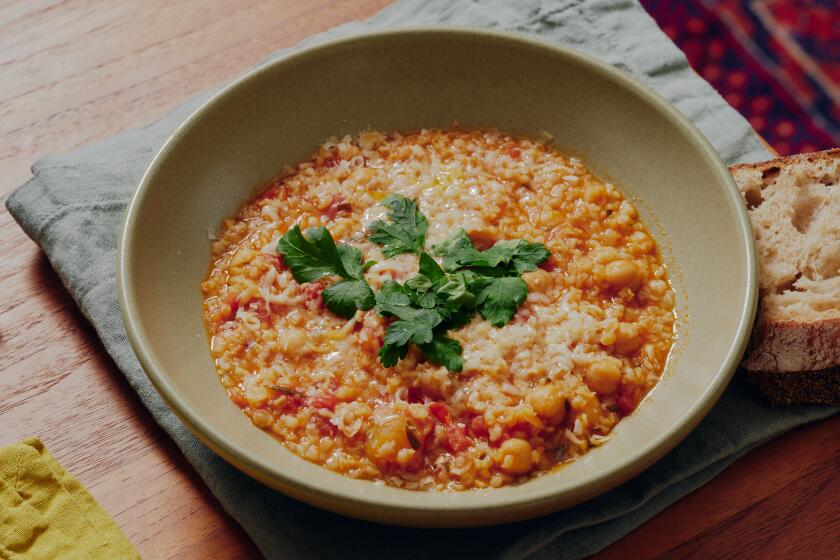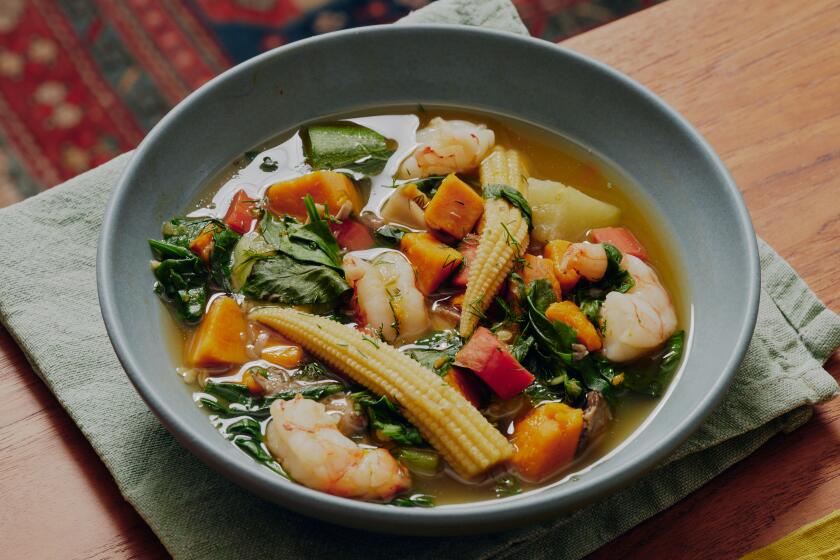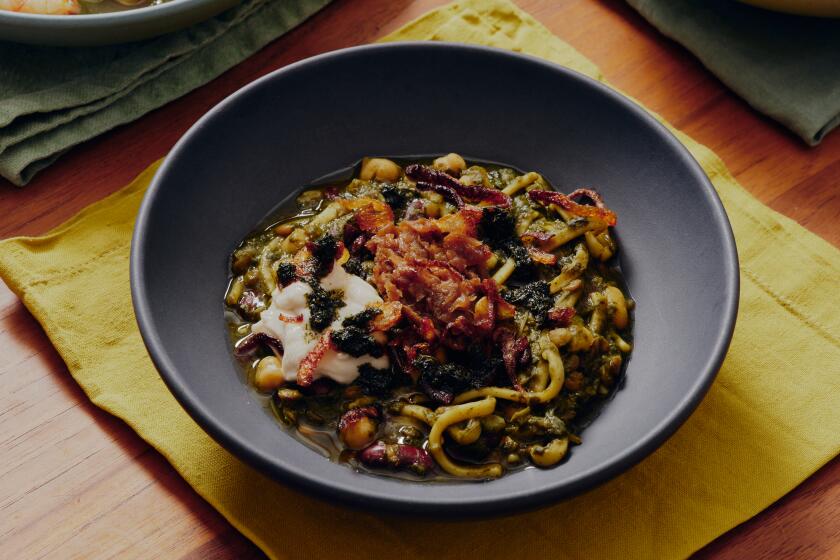Clam chowder
It’s late Christmas morning and all of the presents have been unwrapped. Even if just for the moment, the kids are lulled into quiet. Southern California’s bright winter sunshine floods in through the windows. Now it’s time for the grown-ups to relax into a long, slow afternoon celebrating their own holiday.
And that, of course, means dinner. Let’s face it, the big Christmas meal is just too good to be delayed. Enjoy it early in the day and not only will you still have some energy, you’ll still have your appetite.
That’s a very good thing, because while Thanksgiving’s menu is bound by tradition and about as scripted as a presidential debate, at Christmas dinner you can really cut loose.
Ladle up a bowl of lightly creamy clam chowder, rich with the flavors of smoky ham and briny shellfish. Think that will wake up your appetite? For the main course: a regal crown roast of pork spiced with apple cider and stuffed with a mix of glazed root vegetables. Finish with a tangy, subtly sweet frozen tangerine souffle topped with chopped pistachios.
Fine, you say, but how in the heck am I going to cook a menu like that on Christmas morning?
Actually with a little bit of planning, it’s easily done. The souffle can be made days ahead. The chowder can be all but finished the day before, so the only thing you need to do Christmas morning is add the cream and heat it through. The pork, of course, must be roasted at the last minute, but how hard is that? And the glazed vegetables for the stuffing reheat nicely.
The chowder is an ideal start for this kind of celebratory meal, delicate in texture and bracingly flavored. It’s a perfectly balanced combination of the best flavors of earth and sea, delivered in gossamer.
--
Honest simplicity
Somehow chowders have become synonymous with soups that are so thick they’ll support not just a spoon but a tent post. But real chowders don’t start with a paste. They begin with cream and potatoes. And other than the seafood, that’s pretty much where they finish. A real chowder has the kind of elegance that comes with absolute simplicity.
In this particular case, you have boiled potatoes (and their cooking water -- more about this in a minute), cream, and clams and their companions.
Though most traditional chowder recipes call for littleneck clams, I prefer to use Manilas. First, they’re tiny, so you can serve them in the shell, and can you imagine anything more appetizing than a bowl full of little clams swimming in cream? Even better, Manilas are farm-raised, which means they are virtually grit-free.
If you prefer littlenecks or another clam, steam them open separately, shell them and chop the meat. Then pass the clam juice through a fine mesh strainer to remove any sand.
With Manilas, chowder is incredibly simple to make. Steam the clams open in a skillet with bacon, celery, onions and white wine. Then combine the clams and their juices (there will be plenty) with the potatoes and the cream. That’s it.
The twist to the dish is one I learned from a James Beard chowder recipe. Boiling the starchy cooking water from the potatoes to reduce it adds a slight amount of thickener to the soup, but what it really contributes is an earthy bass note to the flavor.
It’s a subtle thing. You might not pick it up in the final dish, but if you tasted the chowder made with the potato water beside one made without it, you’d definitely notice the difference.
Despite its regal appearance, the crown roast is also incredibly simple to make. Most of the hard work is done by the butcher -- you should start with the roast rolled and tied and the chop bones already stripped clean of meat and scrap (chefs call it “frenching”).
Because pork loin tends to be so lean, it really benefits from brining before roasting in order to stay moist. This particular brine is a mixture of apple cider and warm spices for flavor, with just enough salt added to increase the moisture-holding capacity of the meat and season it through.
Some cooks add sugar to brines. This isn’t as awful with pork as it is with turkey (to my taste, a sweet brine makes even a heritage bird taste like luncheon meat). But even with pork, you do need to be careful: too much sugar and your roast will taste like ham.
The amount of natural sugar in the apple cider is sufficient to add a subtle sweetness to the pork without being too noticeable. The same is true of the spicing -- there is just enough to accent pork’s rich flavor without making it taste like potpourri.
Steep the spices first by simmering them in water to extract the flavor, then add the cider. This will cool the brine enough that you can use it almost immediately, and it preserves the cider’s fresh apple flavor.
Though pork is always one of the most accommodating of meats, nothing complements its flavor better than root vegetables.
And nothing complements the flavor of root vegetables better than more root vegetables. It’s the mix of subtleties that creates a depth of flavor far greater than any of the vegetables could hope for individually.
This is really one of those cases where specific measurements and proportions are almost beside the point. Start with carrots, since they are so readily available. Then add turnips; their peppery bite will balance the sweetness. And then chuck in whatever else you can find -- parsley root, celery root, rutabagas, parsnips. They’ll each add a distinctive note to the sweet, earthy mix.
All of these have roughly the same texture, so you can cook them together and they’ll soften at the same time. The only real trick is making sure they’re cut to about the same size. Naturally, there will be different shapes, but that’s not a problem. Actually, I find the mix of shapes and colors part of the appeal.
When the crown roast is almost done, fill the center with as much of the glazed root vegetables as it will hold. Despite appearances, that won’t be a heckuva lot -- you don’t want to pack the vegetables in because they’ll break up. To get that meaty finish for the rest of the vegetables, turn them in the hot browned juices that remain in the pan after you’ve removed the roast for resting and carving.
--
Semifreddo or something
After that kind of rich main course, what’s needed is a dessert that is cool and creamy, tart and just a little bit sweet.
Though hot souffles seem to be making something of a comeback, you almost never hear about cold souffles anymore. Maybe that’s because so many of them being served today are called semifreddos.
Trendy linguistics aside, there are few things that taste better.
Just to be clear, a cold souffle is not a hot souffle served at room temperature. Instead, it’s closer to an ice cream, but one with an exceptionally delicate texture.
There are various ways to achieve this, but my favorite is the one I learned many years ago from cooking teacher Madeleine Kamman (who says she learned it from the great French chef Henri Paul Pellaprat).
Start by beating egg yolks and sugar over simmering water. The mixture will get thick and full and sticky. When you rub a little between your fingers, it should be smooth -- this tells you the sugar is fully incorporated.
Beat into this some tangerine zest and juice that you’ve thickened with gelatin. During freezing, the gelatin will keep the thin juice from settling to the bottom of the dish, and it also will absorb any excess moisture, keeping the mixture from getting icy.
If you fold this mixture into lightly whipped cream, you’ll have made a Bavarian cream, which is great for filling eclairs and cream puffs (and pretty darned good by itself).
Instead, fold it first into stiff egg whites and then into the soft cream, making the texture even lighter.
Once this is done, you simply pour the mixture into a souffle dish (fit it first with a collar made of waxed paper or aluminum foil, so the top will pop up above the rim of the dish). Stick it in the freezer. And, basically, forget about it.
The frozen souffle can be made two or three days in advance. Once it’s frozen solid, just cover the top with plastic wrap to keep it fresh. Before serving, let it soften slightly in the refrigerator and then sprinkle the top with chopped pistachios.
And when you’re done, there’s still enough time -- and energy and light -- for a nice long Christmas walk.
Cut the potatoes into bite-size pieces and put them in a medium soup pot. Add enough water to cover generously, season with one-half teaspoon salt and bring to a boil. Reduce the heat to a simmer and cook until the potatoes are tender, about 15 minutes.
Remove the potatoes from the cooking water with a slotted spoon and set them aside in a bowl. Don’t worry about little pieces that break off in the water; they’ll help thicken the chowder. Return the cooking water to high heat and reduce by half.
Cook the bacon and the butter in a large skillet over medium heat until the bacon renders its fat and begins to brown, about 8 to 10 minutes. Discard all but about 2 tablespoons of the fat and add the celery, onion and thyme. Cook until the vegetables are tender, about 5 minutes.
Add the white wine and cook to burn off the alcohol, 2 to 3 minutes. Add the clams, cover tightly and increase the heat to high. Cook until the clams have opened, about 3 minutes. If there are some clams that are still closed tight, cook for 1 to 2 minutes more. After that, discard any that don’t open.
Add the clams, their juices and the potatoes to the soup pot with the potato cooking water. (The recipe can be made to this point up to 1 day in advance and refrigerated tightly covered.)
Add the half-and-half and cream to the clams and potatoes and cook over medium-low heat until the mixture is warmed through, about 5 minutes. Cook just until a skin forms on the surface of the cream. Do not overcook or the cream will separate. Season to taste with salt and freshly ground pepper, and ladle into heated soup bowls. Combine the parsley, lemon zest and chives in a small bowl and sprinkle a little of the mixture over each serving.
Get our Cooking newsletter.
Your roundup of inspiring recipes and kitchen tricks.
You may occasionally receive promotional content from the Los Angeles Times.
















